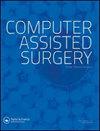Automatic segmentation of arterial tree from 3D computed tomographic pulmonary angiography (CTPA) scans
IF 1.9
4区 医学
Q3 SURGERY
引用次数: 13
Abstract
Abstract Pulmonary embolism (PE) and other pulmonary vascular diseases, have been found associated with the changes in arterial morphology. To detect arterial changes, we propose a novel, fully automatic method that can extract pulmonary arterial tree in computed tomographic pulmonary angiography (CTPA) images. The approach is based on the fuzzy connectedness framework, combined with 3D vessel enhancement and Harris Corner detection to achieve accurate segmentation. The effectiveness and robustness of the method is validated in clinical datasets consisting of 10 CT angiography scans (6 without PE and 4 with PE). The performance of our method is compared with manual classification and machine learning method based on random forest. Our method achieves a mean accuracy of 92% when compared to manual reference, which is higher than the 89% accuracy achieved by machine learning. This performance of the segmentation for pulmonary arteries may provide a basis for the CAD application of PE.三维计算机断层肺血管造影(CTPA)扫描中动脉树的自动分割
摘要肺栓塞(PE)和其他肺血管疾病,已被发现与动脉形态的变化有关。为了检测动脉变化,我们提出了一种新的、全自动的方法,可以在计算机断层肺血管造影(CTPA)图像中提取肺动脉树。该方法基于模糊连通性框架,结合三维血管增强和Harris Corner检测实现精确分割。该方法的有效性和稳健性在由10次CT血管造影术扫描组成的临床数据集中得到了验证(6次无PE,4次有PE)。将该方法的性能与基于随机森林的人工分类和机器学习方法进行了比较。与手动参考相比,我们的方法实现了92%的平均准确率,高于机器学习实现的89%的准确率。肺动脉分割的这种性能可以为PE的CAD应用提供基础。
本文章由计算机程序翻译,如有差异,请以英文原文为准。
求助全文
约1分钟内获得全文
求助全文
来源期刊

Computer Assisted Surgery
Medicine-Surgery
CiteScore
2.30
自引率
0.00%
发文量
13
审稿时长
10 weeks
期刊介绍:
omputer Assisted Surgery aims to improve patient care by advancing the utilization of computers during treatment; to evaluate the benefits and risks associated with the integration of advanced digital technologies into surgical practice; to disseminate clinical and basic research relevant to stereotactic surgery, minimal access surgery, endoscopy, and surgical robotics; to encourage interdisciplinary collaboration between engineers and physicians in developing new concepts and applications; to educate clinicians about the principles and techniques of computer assisted surgery and therapeutics; and to serve the international scientific community as a medium for the transfer of new information relating to theory, research, and practice in biomedical imaging and the surgical specialties.
The scope of Computer Assisted Surgery encompasses all fields within surgery, as well as biomedical imaging and instrumentation, and digital technology employed as an adjunct to imaging in diagnosis, therapeutics, and surgery. Topics featured include frameless as well as conventional stereotactic procedures, surgery guided by intraoperative ultrasound or magnetic resonance imaging, image guided focused irradiation, robotic surgery, and any therapeutic interventions performed with the use of digital imaging technology.
 求助内容:
求助内容: 应助结果提醒方式:
应助结果提醒方式:


